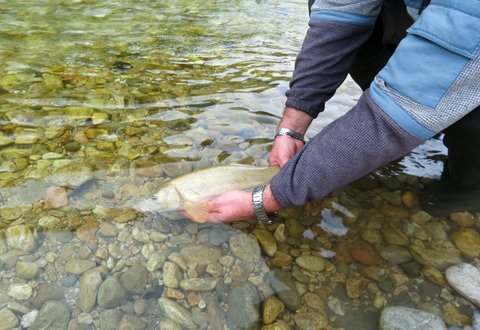Catch-and-release fishing plays an important role in maintaining and improving our fisheries. Anglers who practice catch-and-release want their released fish to survive so they grow larger and continue to reproduce. Following a few key tips will help ensure that the fish you catch will survive once you release it back to the water.
Barbless hooks: Using barbless hooks causes less damage to the fish and can significantly reduce the time it takes to unhook the fish and get it back in the water. This can play a major role in helping the fish to survive.
Keep fish in the water: If you can unhook a fish while it is still in the water, you reduce the trauma to the fish caused by taking it out of the water and handling it.
Wet hands: Before handling a fish, wet your hands first. This limits the amount of mucus that is removed from fish when it’s in your hands. It also reduces the amount of dirt or other materials that might be transferred from your hands to the fish.
Don’t touch the gills: The gills are one of the most sensitive parts of a fish. They can be easily damaged, resulting in a fatal injury. Take all precautions to avoid touching the gills.
Holding the fish: When handling a fish, gently hold it by the mid-section or cradle it from the belly and tail. An exception is the large or smallmouth bass, which can be held by the lower jaw. Using these techniques will reduce injury to the fish and improve the odds of survival.
Quick fight: When playing a fish, get it in as quickly as possible. Playing the fish too long puts a significant amount of stress on the fish and reduces the chances for survival.
Camera ready: If you know you will be taking photos of the fish you catch, have your camera ready to go so you can quickly take a photo and release the fish. Taking the time to search for a camera, get it ready and take a photo can cause unneeded trauma to the fish.
Deep hooks: If it is impossible to unhook the fish, without causing severe damage to the fish, the best bet is to cut the line. This will improve the odds of the fish surviving.
Landing net: Although a landing net can remove the mucus on a fish, a landing net can help reduce the time it takes to land and release larger fish. It can also reduce the chances the fish hitting the boat and injuring itself.
There are times when, despite an angler’s best efforts, a fish becomes injured and is bleeding. If the fish is legal to keep, it’s probably best to keep that fish because its chances for survival are not good.
Successful catch-and-release angling can take a little more effort, but the reward comes in improving and preserving the fisheries we enjoy.








